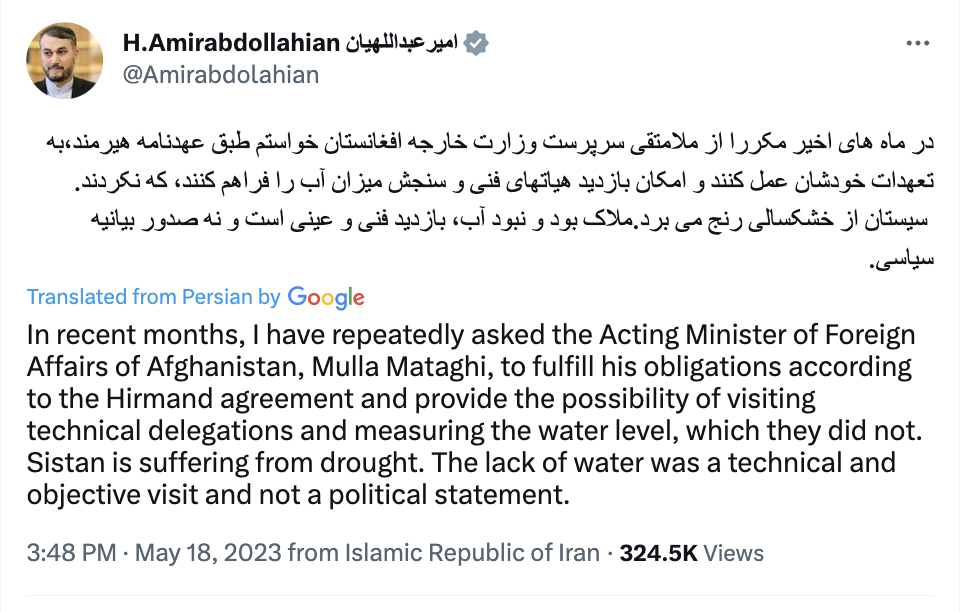Situational Assessment — Iran
Image Credit: Google Maps
Key Figures
In the morning of May 27, heavy gunfire was exchanged between Iran and Afghanistan’s Taliban at the Sasuli border post, located in Iran’s Zabol county in the southeastern part of Iran.
Both parties blamed each other for shooting first. On the Taliban side, the spokesman of the Taliban-run Interior Ministry, Abdul Nafi Takor, accused Iran of shooting first and said that one person has been killed on each side and that there were several injured. However, the Iranian side alleged the Taliban initiated the gunfire and “were met with a decisive and courageous counteraction from the border guards,” according to the Iranian Brigadier General Qasem Rezaei, deputy commander of the national police. The Islamic Republic News Agency, IRNA, reported that two Iranian border guards had been killed and two Iranian civilians were injured.
According to the human rights organisation HaalVsh, residents from the province of Sistan and Baluchestan reported that heavy fighting took place near the Kang district of Nimroz (Video footage 1, Video footage 2, Telegram video).
Reuters reported that the Iranian authorities closed the Milak – Zaranj border post, a major commercial crossing, after the incident.
On the afternoon of May 27, the clashes continued and the Iranian commander Brigadier General Rezaei issued a directive to the border guards, asking them to “defend the borders bravely and decisively and not allow any trespassing or encroachment” according to the Iranian state media. Later that day, the Iranian border guards reportedly engaged with “unidentified armed individuals who intended to enter the Islamic Republic of Iran” at the Zabol border. “The Iranian border guards inflicted significant damage and casualties on the armed individuals through their heavy fire superiority” as reported by IRNA.
Enayatullah Khowarazmi, Taliban defence ministry spokesman, reportedly stated that "Unfortunately, today once again in the border areas of Kong district of Nimroz province, there was a shooting by Iranian soldiers, (and) a conflict ... broke out." Enayatullah Khowarazmi, the Taliban’s defence ministry spokesman, called for “dialogue and negotiation” to appease the tensions with Iran according to the Islamic Republic News Agency.
On May 27 evening, calm reportedly returned at the border between Iran and Afghanistan in the Iranian provinces of Sistan and Baluchistan according to the deputy governor of Sistan and Baluchistan Alireza Marhamati. He also stated that officials from both countries have held talks and negotiations. Despite Iran saying the clashes are over and the situation is in control, Taliban sources have released videos of capturing an outpost inside Iran on May 27 evening.
Source: Twitter.
On May 28 reports from Iran International and the human rights organisation HaalVsh reported that deputy commander of Iran's Law Enforcement Forces and Kiumars Heydari, the Commander of the Iranian Army's Ground Forces, travelled to Sistan-Baluchestan province bordering Afghanistan to probe the situation. Heydari stated that the situation is under control and that security is “fully established”. ““Our comrades in border guards and ground forces are completely dominant in the region, and as long as Afghanistan’s forces respect international regulations, we will show mutual respect and maintain the policy of good neighbourliness,” but if the other side does not want to comply with the regulations, Iranian forces will encounter them”.
On May 29, the Islamic Republic News Agency, IRNA, reported that the Interior Minister of Iran, Ahmad Vahidi, stated that “a proper response has been given to the Afghan border guards” and that there is “no problem in the border crossing between the two countries.” According to Ahmad Vahidi, the conflict at the joint border lines is minor and that the border is now open and calm.
Water Dispute amid Increased Drought
Image Credit: Google Maps and Atlantic Council.
This incident broke amid rising tensions over water sharing rights. According to the IRNA, the Taliban reportedly failed to honor a water-sharing treaty from 1973 as the Iranian authorities “insist that the Taliban in Kabul restrict the flow of water from the Helmand River to Iran’s arid eastern regions”. This accusation has been rejected by the Taliban’s spokesman.
On May 18, Iranian President Ebrahim Raisi warned the Taliban not to violate water rights over their shared Helmand River. “We will not allow the rights of our people to be violated” and also urged the Taliban to allow Iranian hydrologists to check the water levels of the river which originates in the Afghan Hindu Kush mountain range. “Iranian officials have always stressed the importance of the implementation of the 1973 Helmand River treaty between Iran and Afghanistan, which envisions shared water resources” since Iran has experienced drought problems for the past few decades. According to the Iran Meteorological Organization, an estimated 97% of the country now faces some level of drought.
In response to this warning, a former Taliban official published a video on social media mocking President Raisi. In the video, General Mubeen Khan, a Taliban figure, holds a bucket saying he wants to give water to Iran.
Source: Twitter
On May 18, Hossein Dalirian, a spokesman of Iran's Aerospace Organization, stated in a tweet that images from Iran's Khayyam satellite indicate that the government of Afghanistan has stopped the waters from reaching Iran by changing the course of the river in some areas and building “numerous barriers.”
In a statement issued on May 22, Amir Khan Muttaqi, Afghanistan’s acting foreign minister called on the Iranian government “not to politicise this vital issue of water. It is optimal for us to resolve such issues through understanding and direct talks instead of making remarks in the media”.
The Helmand river is 1,000 kilometres long and flows from Afghanistan into Iran’s arid eastern regions. This source of water has been a matter of concern for both countries with Iran concerned about drought issues and Afghanistan’s willingness to dam it to generate electricity and irrigate agricultural land.




